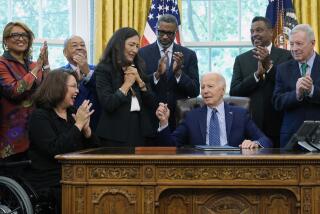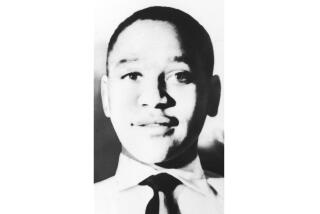Illinois Reverently Remembers Its Favorite Son
- Share via
LINCOLN, Ill. — When developers began planning this town in 1853, they hired an attorney to draw up the legal papers.
Not knowing what to call the place, they decided to name it after the attorney who later would become the 16th President of the United States. It was the first--but far from the last--town named in his honor. Today, towns named for Abraham Lincoln can be found nationwide and in some foreign countries, on street signs, buildings and schools.
But Lincoln’s impact is most evident in Illinois, also known as “Lincoln Country” or “The Land of Lincoln.” As a circuit-riding attorney serving 14 county seats in central Illinois, Lincoln crisscrossed the state. His political campaigns took him to still other corners of the state where plaques, statues, monuments and buildings recall his appearances. Almost everywhere in Illinois there is something named in his honor.
Name Is Everywhere
In the town of Lincoln, population 15,000, “practically everything is named for him,” said Matt Mason, 31, a printer for the weekly Lincoln Courier.
But perhaps most notable are the state’s many statues in his honor. Some are quite unusual, like the slice of watermelon that carries this inscription: “Near this site Abraham Lincoln christened the town with the juice of a watermelon when the first lots were sold Aug. 27, 1853.”
At the Vermilion County Museum in Danville, Ann Hillenburg, 33, was busy adjusting the pant leg on a Lincoln mannequin in stocking feet. Lincoln is shoeless, Hillenburg explained, because he had walked from the Danville railroad station to the home of his friend and kicked off his boots in the bedroom.
“It happened during Lincoln’s unsuccessful campaign for the Senate against Stephen A. Douglas,” she said. When a crowd gathered outside the home to see Lincoln, he made an appearance in his stocking feet because his feet were so swollen, he couldn’t get his boots back on.
Other statues depict Lincoln debating in the town of Freeport; reading a book while riding a horse at New Salem; sitting on a stump, an ax by his side, at Millikan University in Decatur.
At the State Fairgrounds in Springfield is a 30-foot-tall “rail splitter” statue of Lincoln holding an ax and wearing an open shirt, rugged trousers and boots. In Clinton, this famous Lincoln quote is inscribed on a statue in town square: “You can fool all the people part of the time and part of the people all of the time but you cannot fool all the people all the time.”
And near Lawrenceville, on the western shores of the Wabash River--just over the Lincoln Memorial Bridge on the Lincoln Memorial Highway--is Nellie V. Walker’s 50-year-old monument to the Lincoln family entering Illinois for the first time on a cold, blustery winter day.
The statue features a bigger-than-life figure of 21-year-old Abe Lincoln leading the family from Indiana to Illinois in an ox-drawn covered wagon.
For the last 13 years in New Salem State Park, Abraham Lincoln’s life has been recalled each summer in “Your Obedient Servant, Abe Lincoln,” a remarkable play written and produced by John Ahart, a theater arts professor at the University of Illinois.
It is presented in a theater built by the Civilian Conservation Corps during the Great Depression. About 100 feet away are the store and post office where young Lincoln worked from 1831 to 1837.
Today, New Salem features 23 reconstructed log buildings typical of Lincoln’s era. A 30-foot-high portrait of him serves as stage backdrop as players reenact his life amid the buzz of katydids and the flickering of fireflies.
It was in New Salem, 20 miles northwest of Springfield, that young Lincoln courted Ann Rutledge. Nearby, in the cemetery at Petersburg, a tombstone reads: “I am Ann Rutledge who sleeps beneath these weeds. Beloved of Abraham Lincoln, wedded to him not through union, but through separation. Bloom forever O Republic, from the dust of my bosom. Jan. 7, 1813-Aug. 25, 1835.”
Buried in Springfield
Lincoln was buried in Springfield’s Oak Ridge Cemetery. The massive tomb in his honor was built with public donations, said Nan Wynn, 34, manager of Lincoln’s Tomb State Historical Site. Last year more than 300,000 people visited the site where Lincoln’s wife, Mary Todd Lincoln, and three of their four sons are also buried.
Only Robert Todd Lincoln lived to manhood. He died at 82 and is buried in Arlington National Cemetery. Abraham Lincoln’s last direct descendant, Robert Todd Lincoln Beckwith, a great-grandson, died at 81 in Virginia in 1985.
The Springfield home where Lincoln and his family resided for 17 years is the centerpiece of a four-block National Historic Site administered by the National Park Service.
A $2.2-million renovation to the house was completed last summer. It is furnished as it was when Lincoln left for Washington in 1861. Among the treasures are 65 original family pieces, including the President’s rocking chair.
Also in Springfield is the law office Lincoln shared with Billy Herndon, the federal courthouse where Lincoln worked as an attorney on 200 cases, the Lincoln family pew in the First Presbyterian Church and the old Great Western Railway Depot where Lincoln bid farewell to his friends and supporters when he left for the White House. The Old State House, too, is preserved where Lincoln served as a representative, laid in state following his assassination and delivered his famous house-divided speech: “A house divided against itself cannot stand. I believe this government cannot endure, permanently half slave and half free. . . .”
One of five original drafts of Lincoln’s Gettysburg Address is on display in the old Capitol.
More to Read
Sign up for Essential California
The most important California stories and recommendations in your inbox every morning.
You may occasionally receive promotional content from the Los Angeles Times.












